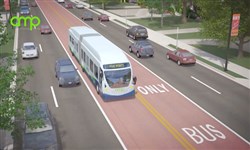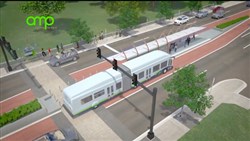VOL. 38 | NO. 2 | Friday, January 10, 2014
AMP planners uninterested in compromise that could increase West End-area support, cut costs
By Jeannie Naujeck

Cutting dedicated lanes and middle-of-the-street stations between 440 and White Bridge could ease concerns of area residents and save millions of dollars.
If Mayor Karl Dean gets his signature $175 million mass transit initiative, The Amp bus rapid transit line, it will be one of his key political achievements.
Most Nashvillians agree on the need for better transit solutions to accommodate coming growth to Davidson County and the greater metropolitan region. But the controversial Amp initiative has the potential to become Dean’s Waterloo – or, worse, his next Fairgrounds.
The 7.1-mile bus rapid transit route between East Nashville’s Five Points area and St. Thomas Hospital on West End Avenue is in design and engineering phases while the administration tries to get public support and build its case for state and federal funding, though Metro Transit Authority spokesperson Holly McCall says the route and 16 stations have been finalized.
The funding mix includes a proposed $60 million from Metro, $35 million from the state and $80 million from federal funds.
It would pay for a BRT system that is essentially light rail service but on rubber-tired vehicles. BRT buses use dedicated road lanes, make fewer stops, utilize stations at which riders buy tickets before boarding, and often incorporate priority signaling to reduce delays at traffic lights.
“You do have to take away a lane of traffic, which is unthinkable in this country,” says Chris Zimmerman, vice president for economic development for Smart Growth America, a Washington, D.C.-area urban resource center.
“But in other places they’ve found the cars move better when they’re done because you take so many people off the street. You’ve got to be willing to do some things that take some money, whether it’s in the roadway or the vehicles or the technology. That takes a certain amount of political will.”
But opponents say the dedicated-lanes design raises real issues along parts of West End where it would severely increase congestion without serving many people.
And one group proposing what it believes is a reasonable, money-saving solution to problems raised by data in the Metropolitan Transit Authority’s own traffic analysis says the MTA is hearing them out – but not really listening.
On Jan. 13, the Metropolitan Transit Authority will begin a round of four public input sessions (“charettes”) to seek out community suggestions for the final design and engineering phase of the Amp.
Attending the West End session will be members of the Richland West End Neighborhood Association, which has raised concerns over the amount of congestion the Amp would generate along the far-western section of the route, which will only serve an estimated 63 additional riders per day, according to MTA estimates.
Like many neighborhoods along the route, Richland-West End has plenty of residents who are opposed to the Amp.
But the Association prepared a carefully thought out compromise solution that it says could save money with a minimal impact on the proposed service.
“Instead of just taking a ‘no’ or a ‘yes’ position, we said, ‘Let’s look at it and see if we can improve the proposed system as it relates to the area where we live,’” says James Kelley, a board member of the association.

Permanent stations in the middle of West End, when paired with two dedicated Amp lanes, would reduce the number of lanes available for cars, leading to worse congestion, opponents say.
“The real question is whether anybody’s really listening.”
The proposal spotlights the narrowness of West End Avenue from I-440 west to Bosley Springs Road at St. Thomas Hospital, the end of the line where a park-and-ride garage will be located.
It also takes into account MTA estimates that only 63 additional riders per day will use the service along that stretch, the lowest ridership along the line.
With a dedicated lane for the Amp, that 1.6-mile portion of the road would have to be widened 40 percent to 50 percent. In addition, three new stoplights would be added along the stretch. Add to that the fact that cars in the park-and-ride would exacerbate congestion on Harding Road by turning right and being stopped at the White Bridge Road bottleneck.
However, if MTA changed the portion of the line west of I-440 from exclusive to non-exclusive lanes, it would eliminate many of the congestion issues and save up to $40 million (based on a build estimate of $25 million per mile) that it would spend to pick up only 63 riders a day.
That’s the plan Kelley says he presented in a meeting with representatives from MTA and the Transit Alliance. But he came away feeling that the design had already been decided.
“Their mission is to build The Amp. There never was a public forum, before the design was decided, as to whether that was the right design. There doesn’t appear to be any mechanism to change the design and that’s the frustrating part,” he says.
Kelley says he can’t think of a reason why MTA can’t simply eliminate the dedicated lanes on the 1.6-mile stretch and add express service instead. Federal funding isn’t dependent on having a minimum percentage of exclusive lanes to route length, MTA reps told him.
“That’s the worst part of this process. We may be talking, but is anyone with authority to make a change listening, and do they have any interest in making a change if there are valid arguments?”
The short answer: No.
Kelley’s compromise is not going to be considered because it’s a “halfway solution” that would not incorporate the time-saving features of BRT, which include traffic signal prioritization, McCall explains.
What’s more, she adds, the January charettes are to hear and answer residents’ questions and concerns about how the design might affect their property and give engineers input.
The discussions “are not a debate about whether or not to do it. We’re moving forward,” McCall says.
While prominent business factions like the Chamber of Commerce and Vanderbilt University support the Amp, opposition includes not only Dean’s political opponents but also some strange bedfellows such as Malcolm Getz, associate professor of economics at Vanderbilt University.
Getz, a self-described liberal Democrat who says he stands with Dean on many issues, says The Amp will have a negative effect on congestion and local business, based on traffic analysis provided by MTA. All along the route, The Amp would increase congestion by removing two lanes of traffic and creating choke points, forcing people to take neighborhood streets as an alternate route and hurting businesses along the way.
A better alternative, he says, is to augment existing bus service with longer hours and more frequent service, and to add circulators and the “BRT Lite” type of express service with fewer stops that has already been deployed on two lines in the city with good results.
“The bus rapid transit successes on Gallatin Road and Murfreesboro Road – without dedicated bus lanes – point to a more affordable strategy,” Getz says.
The Murfreesboro Road installation even attracted a federal grant, he points out. In contrast, state officials unenthusiastic about financing The Amp, and federal support remains in doubt given declining federal budgets, he says.
The big question is whether Nashvillians use The Amp.
The key to this might be frequency and predictability. On Cleveland’s HealthLine, so named because Cleveland Clinic and University Hospitals purchased naming rights, hybrid electric buses run 6.8 miles from downtown to East Cleveland along Euclid Avenue, connecting medical and business centers and cultural and educational institutions.
It runs 24 hours a day, with service every five minutes during mornings and afternoon rush hours, and less frequently in off-peak hours. Annual rides are estimated at 4.8 million as of Nov. 1, 2013, according to the Greater Cleveland Rail Transit Authority.
The $200 million investment is credited with catalyzing $5 billion in economic development and growth, including 4,000 new residential units, along the corridor.
Such growth is coming to Nashville and will impact congestion severely among the major commercial corridors, which include West End.
“They’re thinking of their experience now,” says Gary Gaston, design director of the Nashville Civic Design Center, says of residents opposed to The Amp.
“They’re not thinking of their experience 10 years from now.”
Most of the line along which The Amp would run is prime location for high-density, mixed-use infill developments that will serve an influx of new residents who will want services within walking, not driving, distance of their homes.
And the younger demographic profile that is coming to Davidson County will also include fewer car owners. Unlike older generations, fewer millennials consider car ownership – or even a driver’s license – a rite of passage or even all that desirable due to factors including cost.
In 1983, 80 percent of 18-year-olds in America possessed a driver’s license but by 2008, only 65 percent did, according to a study conducted by the University of Michigan Transportation Research Institute and financed by a consortium including major auto makers.
About a third of those ages 18 to 39 without a license cited the cost of owning a vehicle as a major barrier. Almost 40 percent said they simply preferred alternate modes of transportation such as bikes or transit.
The carless can also now request rides via the app-based peer-to-peer ride services Lyft and Uber, both of which debuted in Nashville late last year, or subscribe to a car-sharing service like Zipcar that lets them use a car when they need. Some even hitch rides by posting messages on Twitter.
In short, the “car culture” that long-time residents have become accustomed to in Middle Tennessee will not be the experience of many who will move here over the next two decades.
Kelley says he understands the issues, and agrees with the need for enhanced public transit options, but adds MTA needs to be open to making reasonable changes on West End, where the one-fits-all system simply doesn’t fit the roadway.
“The whole premise of The Amp is high-density population,” he explains. “From Five Points to 440, that’s all commercial, and zoning also allows for high-density apartments and condos. But then when you go west of 440, it’s just a completely different environment. It’s residential, it’s low-density zoning,” he says.
“So why put in a system that was designed for a completely different environment? Why not build The Amp up to 440 and then have the buses run in the right lane, what they call BRT Light, out to St. Thomas?
“You can always build exclusive lanes later, but if you spend the money, you’re never going to undo it.
“That’s what’s frustrating. The MTA people acknowledge that this is all true, but so what?”